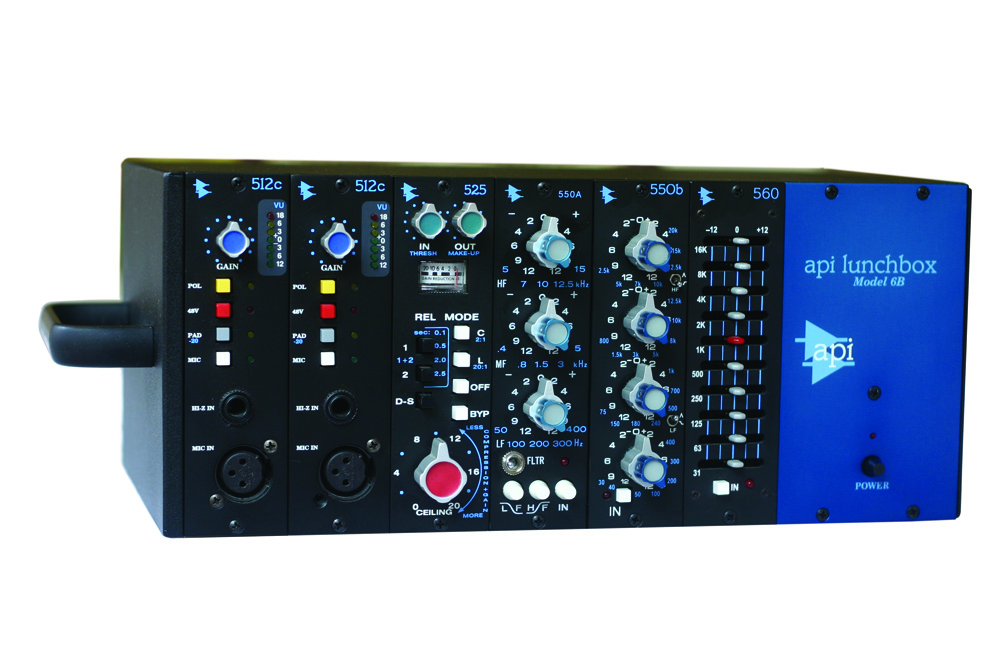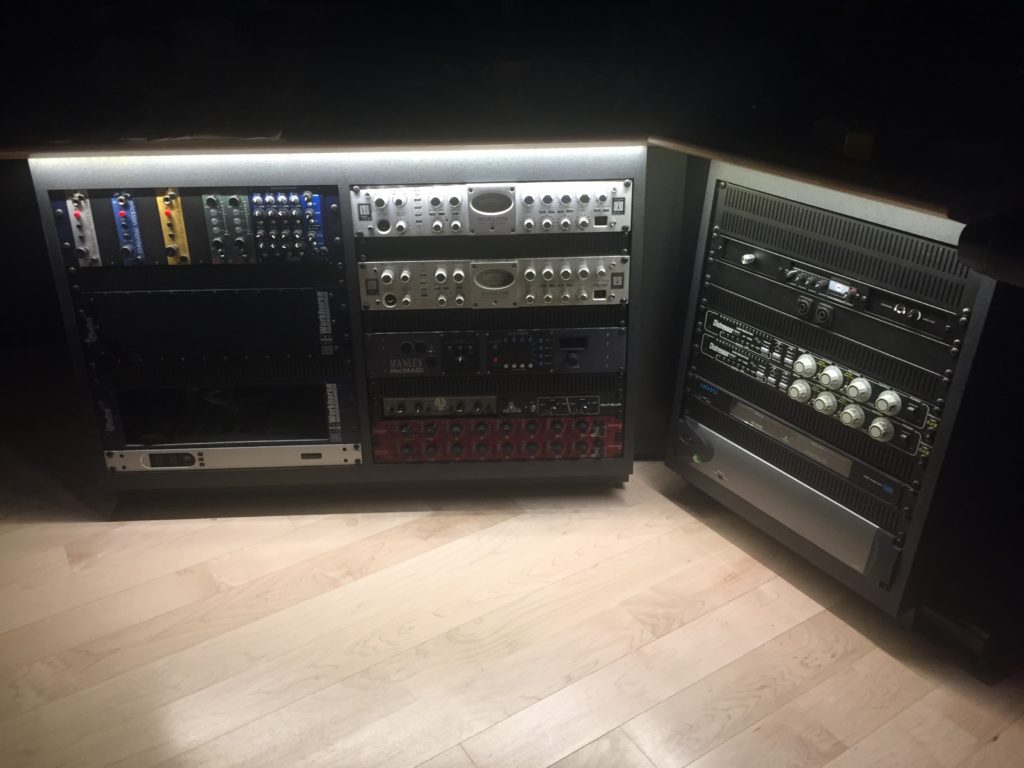When we designed our studio, we knew we weren’t going to have tons of space for outboard gear. So we’ve become big fans of 500 Series gear.
The 500 Series format was developed by Automated Processes, Inc. (“API”) for use in their recording consoles back in the 1970s. It was a standardized, modular format that would let the console owner install one of a couple of different flavors of preamp, EQ and compressor in the signal chain of each channel strip. These API modules sounded really great, and the original units maintained a reputation for a particular sound that is still desirable today, some 40 years later. As studios retired their 1970s-era consoles, they found that they still wanted that “API sound” for their DAW-based projects. Having a few extra, great-sounding modules around that you could take to a live concert recording session, or to a remote studio where you would be recording, was a nice problem to have, too. So API began to offer a “lunchbox,” a metal box that would allow users to use the modules outside their traditional space in a large format analog console. The format has really taken off since then. While API still makes 500 Series-compatible consoles today, there are dozens of companies, if not more, offering modules in the 500 Series format.

With the kind of work we do, most of the time it’s more important that we can easily (and fully!) recall whatever we’ve been working on, rather than having a dedicated analog signal chain for each channel strip on the board. While there are analog consoles these days that allow some pretty extensive recall, we liked the full Pro Tools integration of Avid’s own line of control surfaces. As such, we went with a large format control surface, the Avid System 5-MC, rather than an analog console. And knowing that we’d do most of our processing using plugins within the Pro Tools environment, we kept our outboard rack fairly small.
Working with Judy Elliott-Brown from WSDG, our thought was that, first of all, anything we could stash in the hallway machine closet, we would. We’ve got a couple of Focusrite Liquid Channel strips out there. They can be fully controlled from an app in MacOS, so you literally never have to touch the actual unit itself. We then planned to have a small sidecar rack near the mix position in the control room for other outboard gear. We’d make room in that rack for some of our larger gear, and devices that had controls we needed to reach, such as our Avalon VT-737sp channel strips. Since we don’t have a dedicated analog console, we set aside a small portion of space (2 RU’s) for some clean, console-style microphone preamps (a pair of 8 channel True Systems Precision-8 units, for 16 channels total). The rest we intended to use for a variety of different preamp tone colors and outboard compression. And with space at a premium, we wanted to do anything we could to cram more gear into the limited space we have.
That’s where the 500 Series modules came in.
We dedicated nearly a full side of the sidecar rack to 3 Radial Engineering 500 Series frames: two 10-space Powerhouses, and an 8-space Workhorse. The Workhorse also includes a small analog summing mixer, which will allow us to at least get our feet wet with analog summing during mixing projects. So we’ve got 28 slots for 500 Series gear in our rack.
I started populating the rack by picking up three different flavors of the Erickson Montessi preamp series from A-Designs: The EM-Blue, EM-Gold, and EM-Silver models. Right about then, I also discovered that there was a whole mess of DIY kits available to build all sorts of different flavors of preamps. I started out by building two of Hairball Audio’s Lola preamps, with an eye toward eventually building four of them (more on these units in a future blog post) (update — that post is here).
You CAN (and do) compress signals “in the box”.
But often times it helps to do some compression during tracking, before the signal ever hits the analog-to-digital converters in your interface.
But I realized pretty quickly that we didn’t have nearly enough outboard compression available for the kinds of projects we’d be doing at the studio. You CAN (and do) compress signals “in the box”, but often times it helps to do some compression during tracking, before the signal ever hits the analog-to-digital converters in your interface. The sounds coming from a miked drum kit, in particular, have huge transients that can overload the A-D converters. So unless you knock some of those transients down, you’re potentially looking at huge clipping problems before the signal has even reached your computer. In the past we’ve always had a couple of really good sounding channel strips (the Avalon 737 and Focusrite Liquid Channel) for recording single vocalists and instruments, but when you start dealing with recording drums, the number of channels you’re dealing with increases pretty quickly. Modern drum recording techniques usually call for somewhere between 8 and 16 separate inputs; we were going to need more outboard compression, and lots of it.
Fortunately, the world of 500 Series DIY kits is not limited to mic preamps. There are all sorts of kits for building outboard compressors, too. So I’ve started thinking about what we’re going to need, and I’ve come across the first kits I’m going to build. I’ll talk about that in my next post.


